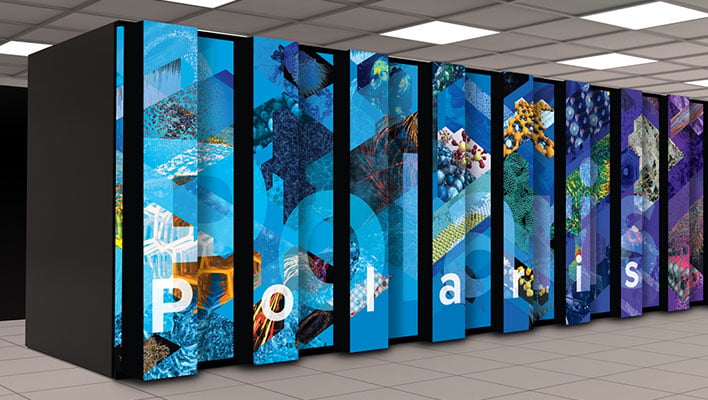NVIDIA Powers Polaris Supercomputer With 2,240 GPUs For Massive AI Workloads

Most people would be happy just to get their mitts on a single GPU, in the current landscape. The US Department of Energy's Argonne National Laboratory is much more fortunate, having procured a whopping 2,240 NVIDIA A100 Tensor Core GPUs (based on Ampere) for its Polaris supercomputer to "supercharge researcher and discovery."
As such, Polaris qualifies as the largest GPU-based supercomputer on the planet, with thousands of A100s working in tandem with hundreds of second-generation and, sometime later, third-generation AMD EPYC server processors.
More precisely, there are 560 nodes spread out over 40 racks, each with four A100 GPUs. As currently constructed, each node features a 32-core/64-thread EPYC 7523 "Rome" CPU based on AMD's Zen 2 architecture. The plan is to swap the CPUs out next year for newer 32-core/64-thread EPYC 7543 "Milan" big iron CPUs based on Zen 3.
In terms of theoretical limits, this all adds up to nearly 1.4 exaFLOPs of AI performance, and 44 petaFLOPs of peak double-precision performance. More than enough to not only run Crysis for sure (before anyone inevitably asks). Obviously it won't be used for playing games, though (at least we don't think so, because as a young Matthew Broderick taught us in WarGames, this is not something to be trifled with).
"The era of exascale AI will enable scientific breakthroughs with massive scale to bring incredible benefits for society," said Ian Buck, vice president and general manager of Accelerated Computing at NVIDIA. "NVIDIA’s GPU-accelerated computing platform provides pioneers like the ALCF breakthrough performance for next-generation supercomputers such as Polaris that let researchers push the boundaries of scientific exploration."
Michael E. Papka, director of ALCF, said having so many A100 GPUs underneath the hood "will have an immediate impact" on crunching through data-intensive and AI HPC workloads, to ultimately "tackle some of the world's most complex scientific problems." Maybe we can finally get some resolution on whether that pesky dress is blue or gold.
Or likely not—there are much more pressing issues at hand, like advancing cancer treatments, exploring clean energy, and pushing particle collision research into new heights as researchers discover new approaches to physics. Still, it'd be nice to have confirmation that the dress is in fact blue (yes, I said it, it's BLUE!).
The use cases will be up to those who are able to use this thing. And to that end, NVIDIA says Polaris will be available to researchers from academia, government agencies, and industry through the ALCF's peer-reviewed allocation and application program.

